- TOP
-
What is
immunity? -
How to keep
the immune system? -
L. lactis Plasma
- What is L. lactis Plasma?
- Effects of L. lactis Plasma
-
Academic Reports and
External
Announcements

Effects on
infectious diseases
L. lactis Plasma has been reported to
be effective against
cold-like
symptoms and various viruses.
01Inhibition of novel coronavirus
proliferation (non-clinical study)
The potential protective effect against
infection with the novel coronavirus
has been confirmed!
In an in vitro study, Vero cells were infected with SARS-CoV-2 (WK-521 variant) under immune cells (pDCs). The cultures for which L. lactis Plasma was added to these had lower viral proliferation than those for which it was not added.
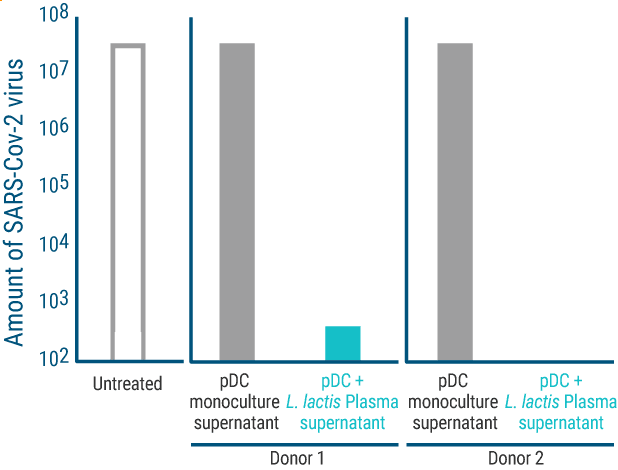
SARS-CoV-2 viral load when Vero cells were infected with SARS-CoV-2
Vero cells: cell line derived from normal kidney of African green monkey
02Cold-like and flu-like symptoms
(adults and children)
Cold-like and flu-like symptoms (adults)
Reduces the risk of cold-like and
flu-like symptoms!
Intake of L. lactis Plasma reduced subjective cold-like and flu-like symptoms such as "cough" and "feverishness".
Cold-like and flu-like symptoms

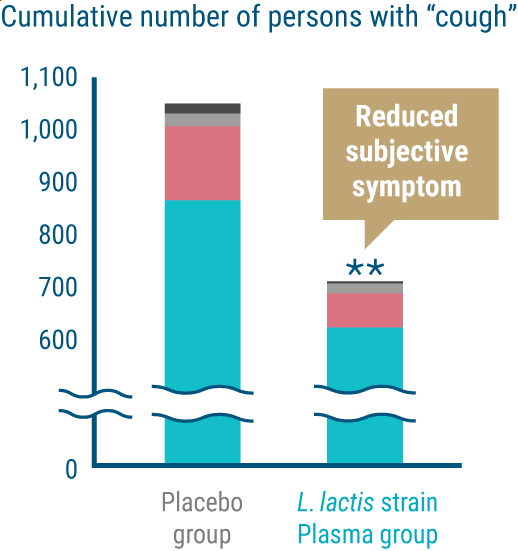
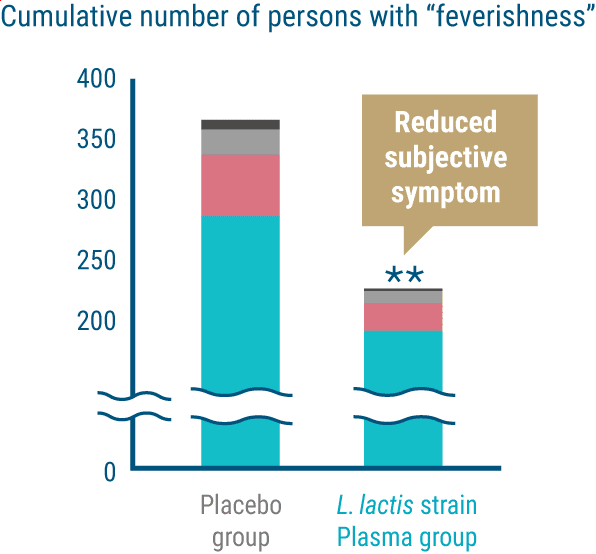
** indicates statistically significant with P<0.01
Source: Br J Nutr. 114: 727-733, 2015.
Cold-like and flu-like symptoms (children)
Reduced the cumulative incidence rate of influenza!
When L. lactis Plasma was distributed to all elementary and junior high school students in the town of Shizukuishi, Iwate Prefecture for three months (three times a week) at school lunches, the cumulative influenza incidence rate decreased compared to that of the adjacent Town A.
Ratio of influenza incidence among elementary
and junior high school students per town

** P<0.01
Source: Health, 9: 756-762, 2017.
Reduction in the cumulative number of days of fever occurrence among
elementary school students in Vietnam!
Healthy elementary school students in Ninh Binh Province, Vietnam, who consumed a beverage containing
L. lactis Plasma for 8 weeks, experienced a decrease in the cumulative number of days with fever and the cumulative number of days absent from school due to upper respiratory infection or gastroenteritis during the intake period.
Cumulative number of days of fever occurrence
among elementary school students in Vietnam
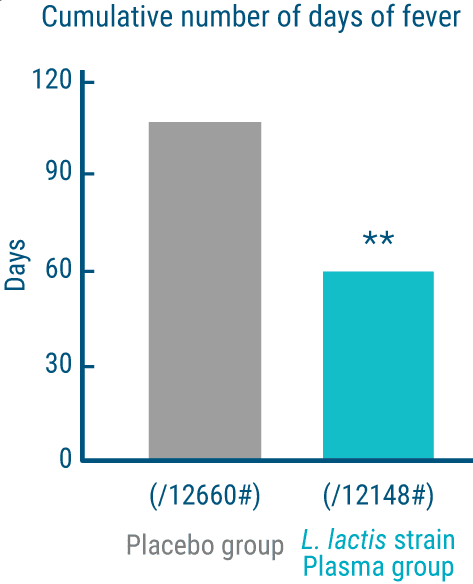
Subject period: 4 weeks from mid-October
** indicates significant difference between groups (p<0.01)
Numbers with # are the total number of days of attendance required for each group.
Source: Nutrients. 14, 552. 2022.
03Effectiveness against dengue virus (clinical and non-clinical studies)
Suppresses dengue virus!
Dendritic cells stimulated by L. lactis Plasma were found to inhibit proliferation of dengue virus.
Comparison of inhibition of dengue virus proliferation
by stimulation from various lactic acid bacteria
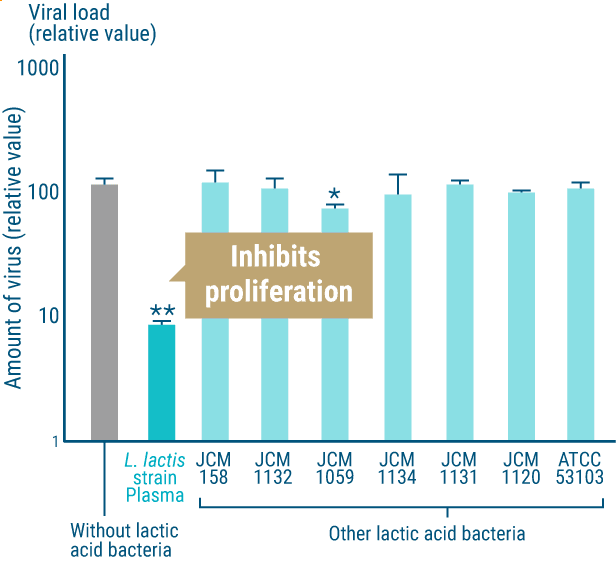
** indicates statistically significant with P<0.01
* indicates statistically significant with P<0.05
Relative to no stimulus
Source: Antiviral Res. 160: 101-108, 2018.
Reduction of occurrence of dengue fever-like symptoms in Malaysia!
When healthy adult men and women living in a region of Malaysia with high incidence of dengue-fever infection ingested L. lactis Plasma for 8 weeks, the cumulative number of cases of dengue-fever-like subjective symptoms and influenza/cold-like subjective symptoms decreased during the period of L. lactis Plasma intake.

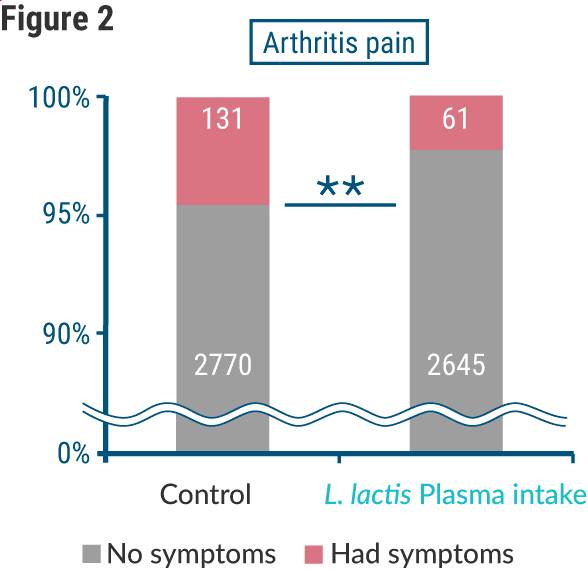
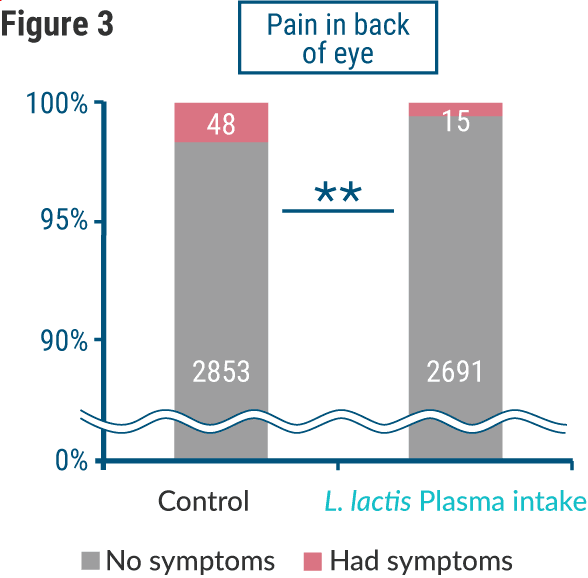
**:p<0.01,Chi-square test
Figures 1-3: Comparison of cumulative number of days of occurrence of dengue fever
and other tropical disease-specific symptoms (typical symptoms)
*Source: Tsuji et al., Antiviral Res (2018) /
Suzuki et al., Int J Mol Med. (2019)
What is dengue virus?
A virus that is carried by mosquitoes such as Aedes species, and causes dengue fever.
Dengue fever occurs mainly in tropical and subtropical areas of Southeast Asia, South Asia, and Central and South America inhabited by the Aedes species and other mosquitos.
The is also an increasing number of cases of infection occurring while visiting foreign countries,
and then the onset of symptoms occurring in Japan.
Reference: NIID National Institute of
Infectious Diseases
Summarized from
https://www.niid.go.jp/niid/ja/encycropedia/392-encyclopedia/238-dengue-info.html
04Rotavirus (non-clinical study)
Inhibits proliferation of rotavirus!
A study of the amount of virus in the feces of mice that ingested L. lactis Plasma showed that the amount of virus in the intestines was reduced and the symptoms of rotavirus infection were relieved.
Comparison of amount of rotavirus
in feces
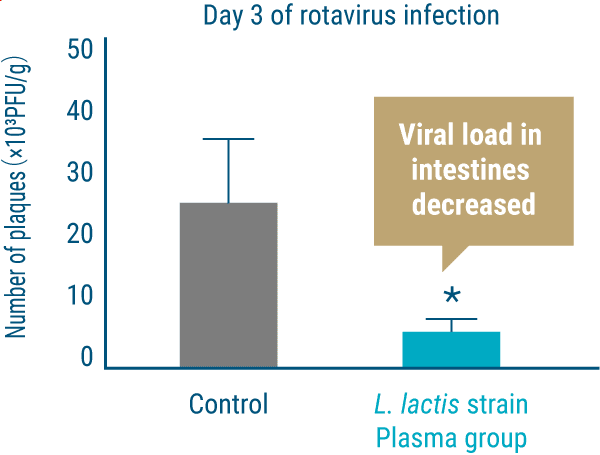
* indicates statistically significant with P<0.05
Source: Int Immunopharmacol., 56; 205-211, 2018.
What is rotavirus?
Rotavirus causes infectious gastroenteritis and is one of the most common viruses causing deaths and infections in children worldwide.
Some reports indicate that 1.8 million deaths of children under the age of five occur annually worldwide, with 80% of these deaths occurring in developing countries.
Prevention of infection is difficult due to its extremely strong infectivity, and although deaths are rare in Japan, the number of infected people is very high, making it one of the most important viruses to deal with among children's infectious diseases.
Reference: NIID National Institute of
Infectious Diseases
Summarized from
https://www.niid.go.jp/niid/ja/kansennohanashi/3377-rota-intro.html



